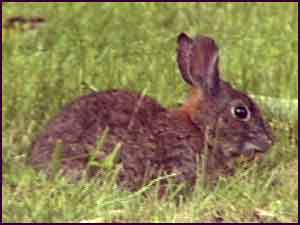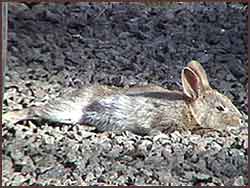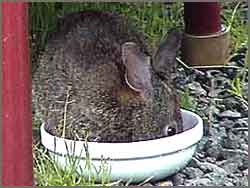Rabbits
Brush Rabbit Video Clips

Before 1912, rabbits and hares were classified in the order Rodentia. After 1912, they were moved into a new order called Lagomorpha. This order includes not only rabbits and hares, but all pikas.
Lagomorphs
Lagomorphs are small to medium mammals with soft fur. The soles of their feet are well furred which helps dampen the shock of rapid hopping. The have long toes that are webbed which keeps them from spreading apart as they jump. When there is a tail, the tail is very short. Their distinctive characteristic is having six (6) incisors. They have two upper sets and one lower set. The first pair of upper incisors are large and each tooth has a long groove on its front surface. The other pair of upper incisors are directly behind the first pair and are small and peg shaped. The incisors are a white enamel color. (Rodents have one pair of incisors and are yellow in color.) Both lagomorphs and rodents have teeth that have no anatomical root which means they continue to grow throughout life. Lagomorphs also have premolars and molars. All lagomorphs are herbivores and they move about by hopping. They do not hibernate in winter.
The Central Oregon Coast has the Snowshoe Hare, Black-tailed Jackrabbit and Brush Rabbit. In our backyard wildlife habitat, we've only seen the Brush Rabbit (Sylvilagus bachmani).
Brush Rabbit Identification
This small reddish brown mottled rabbit measures between 11 and 14 inches in length. The ears, short and dark, are 2 to 2-1/2 inches long. Its tail is small and grey, unlike the Cottontail rabbit known for its large, white tail. They weigh 1 to 2 pounds. Females are generally a little larger than males.
Brush Bunny Behavior
Brush rabbits thrive in thickets of wild roses, blackberries, willows, elderberries and other low growing vines, shrubs and vegetation. These locations are perfect for building runways and tunnels under and through the vegetation.
Because they don't hibernate, Brush bunnies are are out and about all year. Although typically nocturnal, we regularly see them from morning until dusk. They are never far from protective vegetation and will bolt for cover if they hear a warning cry from a bird, chipmunk or squirrel.
Brush rabbits have a limited ability to climb short distances up trees and bushes. When being pursued, they run in a zig-zag pattern and can run up to 20 to 25 miles per hour. Predators are lynx, coyotes, hawks, raccoons, crows, snakes along with domestic cats and dogs.
When they are scared or in pain, they are extremely vocal. Sometimes, they sit very still to avoid being seen. Sometimes, if they are spooked or get frightened, they thump their back foot and can continue thumping for several minutes.

As you can see from the smile of contentment on his face and in his eyes, bunnies love basking in the sunshine. They always make sure cover isn't more than a hop away.
Reproduction
In Oregon, Brush rabbits breed from February through August. The mother digs a shallow cavity or burrow and lines it with grasses and fur and then makes a plug from dried vegetation. She covers the nest with this plug or blanket of grass before leaving the nest.
In July, 2005, we watched a a female rabbit collect dried grass (nesting material) from the lawn area. With her mouth full of grass, she jumped over a foot high and two feet into a clump of plants next to the house. Then she emptied the grass from her mouth, did some arranging, and jumped back over the top of the plants into the lawn. When this leaping lagomorph was finished nest building, she pulled the plants over the nest to help hide it. Jumping over the top of plants into an area will ensure her nest and babies a little safer from predators as there won't be a scent trail directly to her nest. You can watch a video clip of her jumping over the plants. This short video was filmed from inside the house.
There are usually 2 to 4 bunnies in a litter. The hares, like our local Snowshoe Hare and Black-tailed Jackrabbits, are precocial at birth. They are born with with fur and functioning eyes and ears. They are also able to hop around within a few hours after birth. However rabbits, like our local Brush rabbits, are altricial at birth. They are naked and helpless. Their eyes don't open until around the 10th day.
A mother rabbit feeds her kits once in the morning and once in the evening with her rich milk. She spends the rest of the day away from the nest so she doesn't attract predators to the nesting site. They mature 4 to 5 months after birth and breed the following spring.
Although rabbits have a high reproductive rate, three out of four rabbits do not survive the next breeding season.
Food Sources
These herbivores prefer to feed at the edges of shrub cover in order to quickly bolt for cover. They feed regularly on grasses, but they also enjoy sedges, clovers, plantains, berries, forbs, buds, bark and leaves of woody plants such as salal and Douglas fir. They enjoy eating new raspberry canes and parts of the wild roses. Their favorite food is green clover.

Underneath a small table, next to cover, we put a dish of rolled oats. Along with the rolled oats, I cut up a few slices of organic dried apples into little bites and place them around the edge of the bowl. Like clockwork, every morning they come by to have their regularly served granola. When blueberries and blackberries are in season, they also get a dish of them. Rabbits are very good at demonstrating their enjoyment with their facial expressions while they eat these luscious berries.
Indian Legend on Rabbits
Check out the Story of The Rabbits. The Lakota Indian Legend tells us about the Rabbit nation heading for doom and how it was able to survive. It's a wonderful Indian legend.
Plight of Mowing & Pruning
The NWF's Backyard Wildlife Habitat program promotes redesigning the backyard without a lawn for many reasons. One very important reason is the safety of the wildlife that you encourage to live in your yard. In Keven Mack's article, Sharing Your Property with Breeding Wildlife - Be Cautious When Performing Yard Maintenance, he writes:
Several species of tree squirrel, and dozens of species of wild birds build their nests in the branches of living trees or shrubs. Every spring, many of these nests are inadvertently knocked down or disturbed when landowners prune their trees and hedges. It is a good idea to carefully inspect any plants that you intend to trim. Some nests are extremely well hidden, so even if you don't spot a nest it is also advisable to observe for a period of time to see whether or not adult animals seem to be coming and going with nesting material and/or food in their mouths. If you detect a nest, or if you suspect that one may be present based on the behavior of adult animals in the area, you can delay pruning the tree or shrub until the nesting activity ceases.
Depending on the habitat available on your property, you may also be sharing your space with ground nesting species. Even in a relatively small yard, ground nesting songbirds like Dark-eyed Juncos may be present, and cottontails may have shallow nests hidden in the grass. Care should be taken when mowing the lawn to ensure that nests aren't exposed and babies killed or injured. You may also wish to let certain areas of your property remain unmowed to encourage ground and grass nesters.
Orphaned Bunnies
As mentioned earlier, a female rabbit only feeds the babies 5 minutes a day and leaves the nest for the rest of the day to keep predators from finding the nest. The babies remain quiet throughout the day.
So, if you find a nest of baby bunnies, you should leave them alone because the mother should return in the morning or evening. If you find yourself in a situation requiring more information about Orphaned Bunnies, the House Rabbit Society can help. This link to their web site provides information on what to do, how to care for orphans along with a link to wildlife rehabilitators.
Rabbit Reads
An especially wonderful and entertaining site on both domestic and wild rabbits is from HopperHome. They have a section on rabbit anatomy that is excellent. This web site is extremely informative and is wonderful for children.
